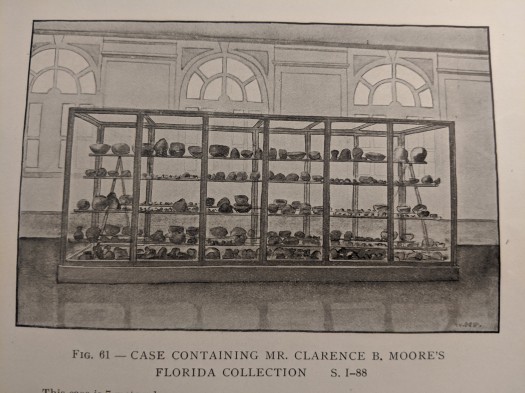Contributed by Ryan Wheeler
There is a New England tradition of visiting southern climes during the coldest months. At the beginning of the twentieth century, archaeological collections made during these southern expeditions ended up in northern museums. The Peabody has a number of such collections, including objects excavated by Charles Peabody and Warren Moorehead at sites in Mississippi, Missouri, North Carolina, and Maryland.

The best-known and most prolific archaeological snowbird, however, is undoubtedly Clarence Bloomfield Moore (1852 – 1936). Moore, from a wealthy Philadelphia family, studied under Frederic Ward Putnam at Harvard. Beginning in the last years of the nineteenth century and carrying through the first two decades of the twentieth century, Moore plied southern rivers during the winter, ultimately excavating hundreds of sites during his career. Only sites not accessible from his steamboat went unexplored. Back in Philadelphia during the summer, he prepared photographs and descriptions of his finds, most of which appeared as large folio volumes in the Proceedings of the Academy of Natural Sciences of Philadelphia.

Moore’s most intensive period of excavation coincided with the establishment of the Phillips Academy Department of Archaeology (now our Peabody Institute). Moore consigned large lots of his collection to the newly created Peabody, reducing what he perceived to be duplicates and largely undecorated pieces of pottery. The result was an extensive collection of ceramic vessels and other artifacts from sites in Florida, Alabama, Georgia, and other Southern and Midwestern states.

Moore’s legacy looms large in southeastern archaeology. He excavated a large number of sites, often completely leveling them. His publications are equally numerous, but are primarily descriptive. His field methods were those of an antiquarian, focused on recovering impressive objects of stone, shell, and clay—and, in fact, he recovered some of the South’s most iconic artifacts. He was generous with his collections, and deposited artifacts with many institutions, from the Springfield Science Museum in Massachusetts to the National Museum of Health and Medicine. George Gustav Heye ultimately acquired the bulk of Moore’s collections, which and are now curated at the Smithsonian’s National Museum of the American Indian. Moore is, however, the person that southeastern archaeologists love to hate—his lack of control, destructive tendencies, and relatively poor record keeping tarnish whatever good he might have done.

In Florida, Moore was so prolific that archaeologists of the mid-twentieth century studied his collections and worked to identify the locations he had visited. Archaeologist John Mann Goggin was chief among these, and assigned Moore’s sites numbers in the state’s catalog of sites. Goggin and his students often tried to visit the sites, when they could be located. He also visited the museums that housed Moore’s collections, using the objects to assign sites to cultural and temporal divisions. Likewise, Gordon R. Willey—best known for his synthetic works on the archaeology of South America and Mesoamerica—used Moore’s collections to develop culture histories for much of Florida’s Gulf Coast and panhandle, including the late Woodland age Weeden Island culture, and the various local manifestations of Mississippian culture. Willey relied on Moore’s collections at the Peabody for this work. The University of Alabama Press has reprinted all of Moore’s publications including new introductions and comments by knowledgeable scholars, and the publications by Goggin and Willey are available as reprints as well.

Moore made several large gifts to the Peabody, with notable collections of pottery, shell, and stone artifacts from sites in the Florida panhandle, the Gulf Coast, on the St. Johns River, and from the Ten Thousand Islands. Several hundred artifacts from at least distinct 88 sites are present in the Peabody collection. A recent reassessment of the Peabody’s Moore collection correlated each site with its contemporary state site number. This project will assist with repatriation and research. Despite earlier assessments of the Peabody’s C. B. Moore collection, few modern scholars know about our holdings. Hopefully, this blog post will help, along with this Excel spreadsheet of Moore sites represented in the Peabody collections: FLorida_Moore_sites_2020
